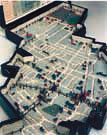
|
|
|

|

|

|

|
|
Click on an image to see a larger, more detailed picture.
|
|
|
|
|
| 1940: Machinery of Hatred |

|
pg. 191 |

|
|
|
|
| |
 In the midst of increasingly difficult ghetto conditions, Lódz Jews sought to maintain the rhythm of normal life. Here, women are pictured baking matzo in a ghetto factory, in preparation for Passover in 1940. Synagogues throughout the city had been destroyed the previous year, but religious life flourished in the ghetto, with families gathering in homes to observe the holy days.
In the midst of increasingly difficult ghetto conditions, Lódz Jews sought to maintain the rhythm of normal life. Here, women are pictured baking matzo in a ghetto factory, in preparation for Passover in 1940. Synagogues throughout the city had been destroyed the previous year, but religious life flourished in the ghetto, with families gathering in homes to observe the holy days.
Photo: YIVO Institute for Jewish Research / United States Holocaust Memorial Museum Photo Archive
|
 Appointed leader, or Eldest of Jews, of the Lódz Ghetto in 1939, Mordechai Chaim Rumkowski pursued the controversial strategy of "quiet and labor" to further the ghetto's survival. This German and Yiddish sign states his motto, "Our only path [to survival] is [through] work." Rumkowski transformed the ghetto into a bustling manufacturing center, producing mainly textiles. Mocked as "King Chaim" by Jews, Rumkowski ruled as a dictator, forcefully quelling all opposition. Nevertheless, his ghetto strategy fell victim to Hitler's goal of exterminating all Jews.
Appointed leader, or Eldest of Jews, of the Lódz Ghetto in 1939, Mordechai Chaim Rumkowski pursued the controversial strategy of "quiet and labor" to further the ghetto's survival. This German and Yiddish sign states his motto, "Our only path [to survival] is [through] work." Rumkowski transformed the ghetto into a bustling manufacturing center, producing mainly textiles. Mocked as "King Chaim" by Jews, Rumkowski ruled as a dictator, forcefully quelling all opposition. Nevertheless, his ghetto strategy fell victim to Hitler's goal of exterminating all Jews.
Photo: Jüdisches Museum / United States Holocaust Memorial Museum Photo Archive
|
 When the Lódz (Poland) Ghetto was liquidated in August 1944, this intricate model was hidden in the basement of a building. It survived the war and was later returned to its builder, Leon Jacobson, who had survived both the ghetto and Auschwitz. The model, constructed from scrap wood, shows the complexities of the ghetto, with its houses, factories, bridges, ruins of synagogues, and cemeteries. In all, the ghetto comprised a bit more than 1.5 square miles. Of that area, less than one square mile had been developed with buildings suitable for habitation. Some 170,000 Lódz Jews were forced into the ghetto, which was served by only two major avenues, and by wooden pedestrian bridges that were constructed over those streets. The official seals and the examples of ghetto currency (upper left) testify to the organization of the ghetto, which was overseen by Jewish Council leader Chaim Rumkowski.
When the Lódz (Poland) Ghetto was liquidated in August 1944, this intricate model was hidden in the basement of a building. It survived the war and was later returned to its builder, Leon Jacobson, who had survived both the ghetto and Auschwitz. The model, constructed from scrap wood, shows the complexities of the ghetto, with its houses, factories, bridges, ruins of synagogues, and cemeteries. In all, the ghetto comprised a bit more than 1.5 square miles. Of that area, less than one square mile had been developed with buildings suitable for habitation. Some 170,000 Lódz Jews were forced into the ghetto, which was served by only two major avenues, and by wooden pedestrian bridges that were constructed over those streets. The official seals and the examples of ghetto currency (upper left) testify to the organization of the ghetto, which was overseen by Jewish Council leader Chaim Rumkowski.
Photo: Arnold Kramer / United States Holocaust Memorial Museum Photo Archive
|
|

|

|

|

|
 February 12-13, 1940: The initial deportations of Jews from Germany, mainly from Pomerania, begins.
February 12-13, 1940: The initial deportations of Jews from Germany, mainly from Pomerania, begins.
|
 February 18, 1940: Two Jewish teenage girls are abducted in Warsaw, Poland, and raped in a Jewish cemetery by two German noncommissioned officers.
February 18, 1940: Two Jewish teenage girls are abducted in Warsaw, Poland, and raped in a Jewish cemetery by two German noncommissioned officers.
|
 February 19, 1940: The use of the Dachau, Germany, concentration camp as a training facility for the Waffen-SS concludes. Prisoners transferred to the Mauthausen, Austria, camp in September 1939 are returned, and Dachau reverts to its original use as a concentration camp; See September 27, 1939.
February 19, 1940: The use of the Dachau, Germany, concentration camp as a training facility for the Waffen-SS concludes. Prisoners transferred to the Mauthausen, Austria, camp in September 1939 are returned, and Dachau reverts to its original use as a concentration camp; See September 27, 1939.
|
 February 21, 1940: Nazis in Warsaw, Poland, throw a Jewish woman from a moving streetcar.
February 21, 1940: Nazis in Warsaw, Poland, throw a Jewish woman from a moving streetcar.
|
 March 12, 1940: All 160 Jews from the Baltic port of Schneidemühl, Poland, are transported to Lublin, Poland, in sealed freight cars, then are forced to march to small villages 20 kilometers away.
March 12, 1940: All 160 Jews from the Baltic port of Schneidemühl, Poland, are transported to Lublin, Poland, in sealed freight cars, then are forced to march to small villages 20 kilometers away.
|
|
|
|
|
| 1940: Machinery of Hatred |

|
pg. 191 |

|
|
The Holocaust Chronicle
© 2009 Publications International, Ltd.
|
|
